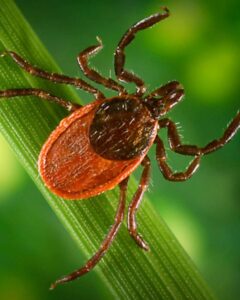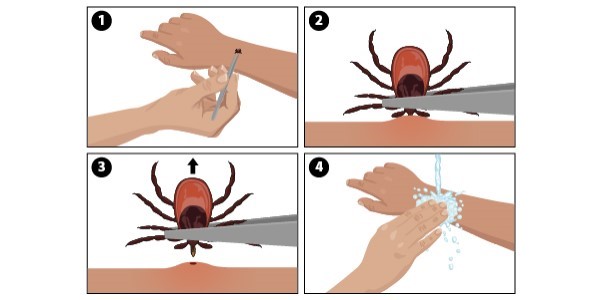Lyme Disease. By Our Student Pharmacist, Patrick Wang.
Tick season is currently at its peak and with it comes a growing concern with contracting Lyme disease.
Lyme disease is an infection caused by a bacteria that is most commonly transmitted through the bite of an infected black-legged tick. Both adolescent ticks, known as nymphs, as well as adult ticks can transmit this bacteria to humans.
This tick finds its home mainly in wooded environments throughout Ohio, so individuals who spend large amounts of time in these areas are advised to have increased caution. Individuals of all age groups are at risk of Lyme disease infection, but boys between the ages of 10-14 and girls between the ages of 5-9 are of particularly high risk.
The characterizing symptom of Lyme disease (about 66% of cases) is a “bull’s eye” rash, which typically appears 7-14 days after the initial infected bite. This rash may be warm, but often is not associated with pain or itching.
Other symptoms include headache, fever, and chills which may appear anywhere between 3-30 days after the initial infected bite.
Lyme disease can only be formally diagnosed by a doctor after the appropriate blood tests are done, so if you experience any of these symptoms and suspect that you have potentially been exposed to black-legged ticks, it is recommended to see your doctor as soon as possible.
Lyme disease is curable through the use of antibiotics, but it is important to seek medical help as soon as possible in order to avoid any further health complications such as neurologic Lyme disease, Lyme carditis, and Lyme arthritis.
Preventative measures include:
- avoiding tick habitats
- using insect repellent that is labeled for use against ticks
- removing ticks promptly
- wearing long-sleeved clothes
Removing ticks:
To remove a tick, simply use a pair of fine tweezers to grab the tick as close to the skin surface as possible. Pull away from your skin with a steady, even pressure. Do not twist or jerk the tick, as this could cause the mouth to break off and remain in the skin. If this happens, attempt to pull it out using tweezers, otherwise just leave it alone and let the skin heal if you’re unable to do so.
Never crush a tick with your fingers. Instead, place live ticks in alcohol, a sealed container, or flush it down the toilet.
Wash your hands and the bite area with soap and water. “Folk” remedies such as petroleum jelly and lighting a match have been shown to not work and so are not advised methods to use.
For more information feel free to visit the Ohio Department of Health’s website at:
Photo References:




